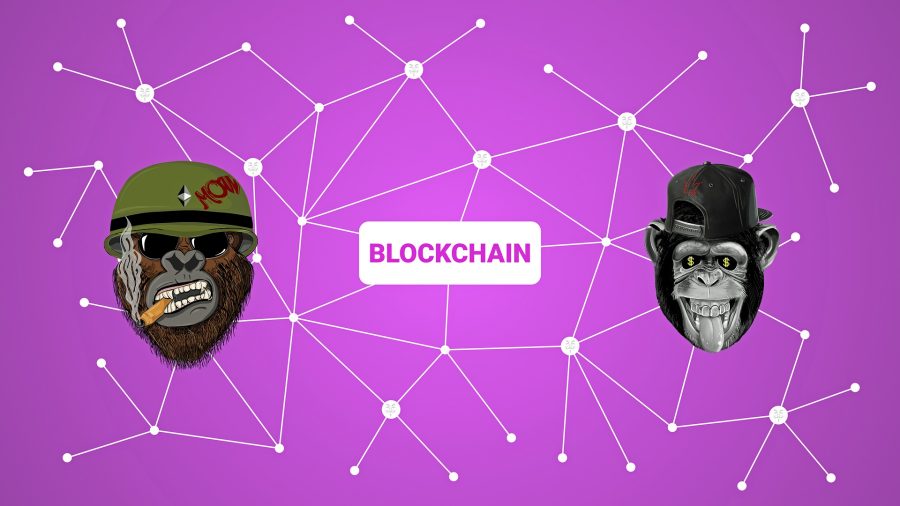The rise of cryptocurrency also saw the rise of NFTs, a new way to digitally “own” something. The new wave of technology is coming along with the metaverse, what are the ramifications of going all digital?
In March of last year, artist Mike Winkelmann — known professionally as Beeple — sold a colorful non-fungible token (NFT) of 5,000 daily pieces he created. He sought to find a market for his unique art — and that he did.
Known already as a talented digital artist on social media, his work sold for over 69 million dollars at Christie’s auction house, whoclaim of being the first major auction house to have sold an NFT based on a digital piece.
On Twitter, some individuals feature profile photos of apes against a solid background. They are known as the Bored Ape Yacht Club (BAYC) NFT images and, unlike Beeple’s artwork, these apes are part of a collection that has recently been expanding beyond the blockchain.
The apes wear varying attire with expressions often appearing nonchalant and disinterested. Their accessories include everything from earrings to vibrant pinwheel hats and because some — like those with golden fur — are rarer than others, they rake in higher prices.
Though initially unassuming and at most charming to an unknowing eye, these images are a part of a competitive and unpredictable market, with some buyers willing to dish out hundreds of thousands of dollars on a single image. Along with the purchase are exclusive, membership-only benefits such as access to the ‘bathroom’ — an online community — and a fluctuating market that can increase individuals’ NFT value.
These “non-fungible” tokens are unique and irreplaceable — akin to rare Pokemon cards. A trading card, for instance, is not interchangeable with another trading card.
NFTs can be purchased on sites like OpenSea and Rarible. For avid buyers, collectors, and sellers, NFTs represent something substantial: something they can own with digital certification. Though the images seem accessible and editable, the ownership aspect is undeniable.
The owner’s name is on a line of code on the Ethereum blockchain or other blockchains, though the latter is much less common. The blockchain holds data securely; they are in the same world of cryptocurrencies and bitcoin. The blocks of data hold transaction information and they form a chain — thus the name.
Original NFTs — either in video or image format — may not deter copies from being made by anyone, but the power of ownership is the main purpose behind purchasing. The transaction history and the metadata that holds the description of the item as well as the creator’s information is associated with the NFT.
As stated by contributing writer Kyle Chayka of The New Yorker, blockchain technology transactions are “permanent and transparent” to all. Though the blockchain is the result of incredible energy consumption, the transactions function efficiently to be very open, insusceptible to modification, and almost impossible to hack.
Creators — like Beeple — can reap royalties from NFT purchases when they are resold. The creator of a NFT, interestingly, also can still retain copyright and reproduction rights.
This blockchain market is special because rarity and desire for the product can be enough to propel the item’s worth. Bored Ape Yacht Club’s initial batch of NFTs brought in more than two million dollars even though it started off small.
Further, Chayka said that when one figure for BAYC goes for a high price, the perceived value of all 10 thousand authentic NFTs in the set also increases in value.
When buyers invest in the work of creators, they are also paving the way for even more investment through an incessantly active market and buyers’ willingness to get their hands on a valuable NFT that can always go up in value later.
Buyers can know that they’re supporting the artist, but the rising popularity of the NFT field gives buyers the opportunity to flip their NFTs and resell them for much steeper prices.
Regardless, this movement is positive for creators who not only share more of their works, but can obtain profit and royalties.
The arena of NFTs also garners some critics — some scoffing at the idea because they equate owning a NFT to simply copying the image and saving it onto their desktop.
“The way I see NFTs [is like] going to a car dealership, getting the top-of-the-line car that costs you thousands of dollars but walking out of the dealership with just the paperwork for the car. That’s all you get,” Bradley Anaya, a junior from Eleanor Roosevelt College, said.
What coincides with the world of NFTs is the metaverse. As the name suggests, the metaverse offers a virtual reality beyond the real environment. One would access it through physical headgear or even a computer screen. The metaverse can coincide with these non-fungible tokens in that what one purchases can also appear in that realm — like an avatar. NFTs are on a compatible Ethereum blockchain that means if something is used with Ethereum, they can be used there too.
There are plentiful opportunities for businesses to ride the coattails of the metaverse and place ads where they want to. Revenue would increase for companies when individuals continue to sell and buy NFTs based on the ads. Section 230 of the Communications Decency Act states that internet services and users are exempt from legal responsibility for content posted on the internet. This kind of news is even better for those eager to participate in the metaverse if it means more freedom for them to conduct themselves as they want.
According to the work “Class, Assets and Work in Rentier Capitalism,” by author Brett Christophers, the term “rent capitalism” refers to the importance placed on rent-generating assets and property. Despite the belief that this would all fade, the metaverse and properties in it echo the strength of profit and the capitalist need to prioritize monopolies — sometimes at the expense of the working class.
Even Author Anna Wiener from The New Yorker states that the development of video game technology, like the extended storage options, allows for more add-ons — all available for purchase. These charges are akin to that of perhaps purchasing an avatar skin or going into a new realm through the metaverse.
Wiener also says that if the metaverse materializes, it will probably act like a video game even if it’s temporary. For instance, those who play the wildly engaging Roblox or Farmville may not be shocked at the latest trend of the metaverse.
The popular game Second Life paved the way for virtual reality — and it started in 2003. The game also has a marketplace where individuals can interact with others and sell and buy items.
Decentraland is also a virtual world platform that allows individuals to incorporate NFTs in the realm through purchases of plots of land. The platform is also part of the Ethereum blockchain, which means NFT purchases and sales would be seamless.
Virtual reality exists with headsets like the Oculus — something that goes for a few hundred dollars. Additionally, stores like Walmart have already experimented with a short video of how shopping can look like through an avatar — from buying milk to a whole television set. The concepts of the metaverse are not new and unheard of. Based on the video and where NFTs are going, the metaverse isn’t a pipe dream either. It also won’t stay limited to games.
Not only have tickets to concerts had the chance to be substituted by NFTs, virtual concerts in collaboration with Roblox bloomed as ways for individuals to feel the thrill of the artists and audience. Skate stores like Vans teamed up with Roblox for the first ever virtual skate park — with interaction through skating in the virtual world as well as Vans gear such as shoes and hats all for sale.
Staff Writer Cecilia D’Anastasio from Wired focused on how the metaverse is really a simple version of online games many have already been playing but what makes the metaverse so fascinating can ultimately be greed or infeasibility at the other end.
She states that big companies like Meta will need to work with other technology companies like Epic Games or Square Enix to create their platforms and services in a seamless way across the metaverse. But there isn’t much hope as the tech companies “are more willing to consolidate than cooperate.”
In a jarring YouTube video by Meta from October last year, the almost hour-and-thirty-minute video features Facebook creator and Meta CEO Mark Zuckerberg amidst different, bizarre backdrops in cartoon form and as himself. Zuckerberg — who renamed Facebook to Meta a few months ago as a symbol of the belief in progressing the metaverse — expressed his enthusiasm in embracing a world where one can take on new identities and roles in richer ways than reality permits.
He believes the metaverse is the successor to the mobile internet. He assures the audience that this belief isn’t about spending more time on screens but rather making the time we already spend better and enhanced.
Though articulate and approachable, Zuckerberg seems deliberately focused on assuaging fears and concerns with fun and vibrant scenes of community — something that the very stiff, unnatural dialogue of his collaborators in most scenes don’t help with.
The realms of NFTs and the metaverse offer a surreal arena to individuals, one in which people can express themselves how they would like. The metaverse intends to be so immersive that one can feel the closeness of individuals next to them — something that would offer convenience and community.
Many individuals expressed their discomfort in comment sections of videos or social media with the idea that a virtual reality will coincide with reality. It is a kind of fear comparable to the uncanny valley of seeing figures that oftentimes look like us — behave.
Zuckerberg re-emphasized safety and security as the biggest priority, but with a world that is set to be almost tangible and utterly realistic, would one be able to discern between realities, particularly if the realm becomes more attractive than the “real” reality?
This new mode of living is far from here, but it is developing. If monetization of everything from images to ads exists, big corporations may take the lead in what we see, based on what they think we’d like to see. When the metaverse arises, the topic of privacy and security will be ceaseless.
Though it might be disingenuous to flip prices or resell an NFT, does it matter as long as the market is still lucrative and incredibly supportive for the artists? After all, though the desire with the metaverse is to implement better for people, profit will always be at the other end of the line.
Image by Chetraruc of Pixabay.















